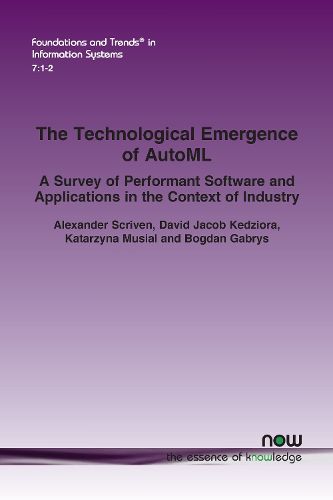Readings Newsletter
Become a Readings Member to make your shopping experience even easier.
Sign in or sign up for free!
You’re not far away from qualifying for FREE standard shipping within Australia
You’ve qualified for FREE standard shipping within Australia
The cart is loading…






This title is printed to order. This book may have been self-published. If so, we cannot guarantee the quality of the content. In the main most books will have gone through the editing process however some may not. We therefore suggest that you be aware of this before ordering this book. If in doubt check either the author or publisher’s details as we are unable to accept any returns unless they are faulty. Please contact us if you have any questions.
The Technological Emergence of AutoML presents a comprehensive snapshot of how AutoML has permeated into mainstream use within the early 2020s. This work surveys both their implementation and application in the context of industry. It also defines what a 'performant' AutoML system is - HCI support is valued highly here - and assesses how the current crop of available packages and services lives up to expectations. To do so in a systematic manner, this survey is structured as follows. Section 2 begins by elaborating on the notion of an ML workflow, conceptually framing AutoML in terms of the high-level operations required to develop, deploy and maintain an ML model. Section 3 uses this workflow to support the introduction of industry-related stakeholders and their interests/obligations. These requirements are unified into a comprehensive set of criteria, supported by methods of assessment, that determine whether an AutoML system can be considered performant. Section 4 launches the survey in earnest, assessing the nature and capabilities of existing AutoML technology beginning with an examination of open-source AutoML packages. The section additionally investigates AutoML systems that are designed for specific domains, as well as commercial products. Subsequently, Section 5 assesses where AutoML technology has been used and how it has fared. Academic work focusing on real-world applications is surveyed, as are vendor-based case studies. All key findings and assessments are then synthesized in Section 6, with commentary around how mature AutoML technology is, as well as whether there are obstacles and opportunities for future uptake. Finally, Section 7 provides a concluding overview on the technological emergence of AutoML.
$9.00 standard shipping within Australia
FREE standard shipping within Australia for orders over $100.00
Express & International shipping calculated at checkout
This title is printed to order. This book may have been self-published. If so, we cannot guarantee the quality of the content. In the main most books will have gone through the editing process however some may not. We therefore suggest that you be aware of this before ordering this book. If in doubt check either the author or publisher’s details as we are unable to accept any returns unless they are faulty. Please contact us if you have any questions.
The Technological Emergence of AutoML presents a comprehensive snapshot of how AutoML has permeated into mainstream use within the early 2020s. This work surveys both their implementation and application in the context of industry. It also defines what a 'performant' AutoML system is - HCI support is valued highly here - and assesses how the current crop of available packages and services lives up to expectations. To do so in a systematic manner, this survey is structured as follows. Section 2 begins by elaborating on the notion of an ML workflow, conceptually framing AutoML in terms of the high-level operations required to develop, deploy and maintain an ML model. Section 3 uses this workflow to support the introduction of industry-related stakeholders and their interests/obligations. These requirements are unified into a comprehensive set of criteria, supported by methods of assessment, that determine whether an AutoML system can be considered performant. Section 4 launches the survey in earnest, assessing the nature and capabilities of existing AutoML technology beginning with an examination of open-source AutoML packages. The section additionally investigates AutoML systems that are designed for specific domains, as well as commercial products. Subsequently, Section 5 assesses where AutoML technology has been used and how it has fared. Academic work focusing on real-world applications is surveyed, as are vendor-based case studies. All key findings and assessments are then synthesized in Section 6, with commentary around how mature AutoML technology is, as well as whether there are obstacles and opportunities for future uptake. Finally, Section 7 provides a concluding overview on the technological emergence of AutoML.